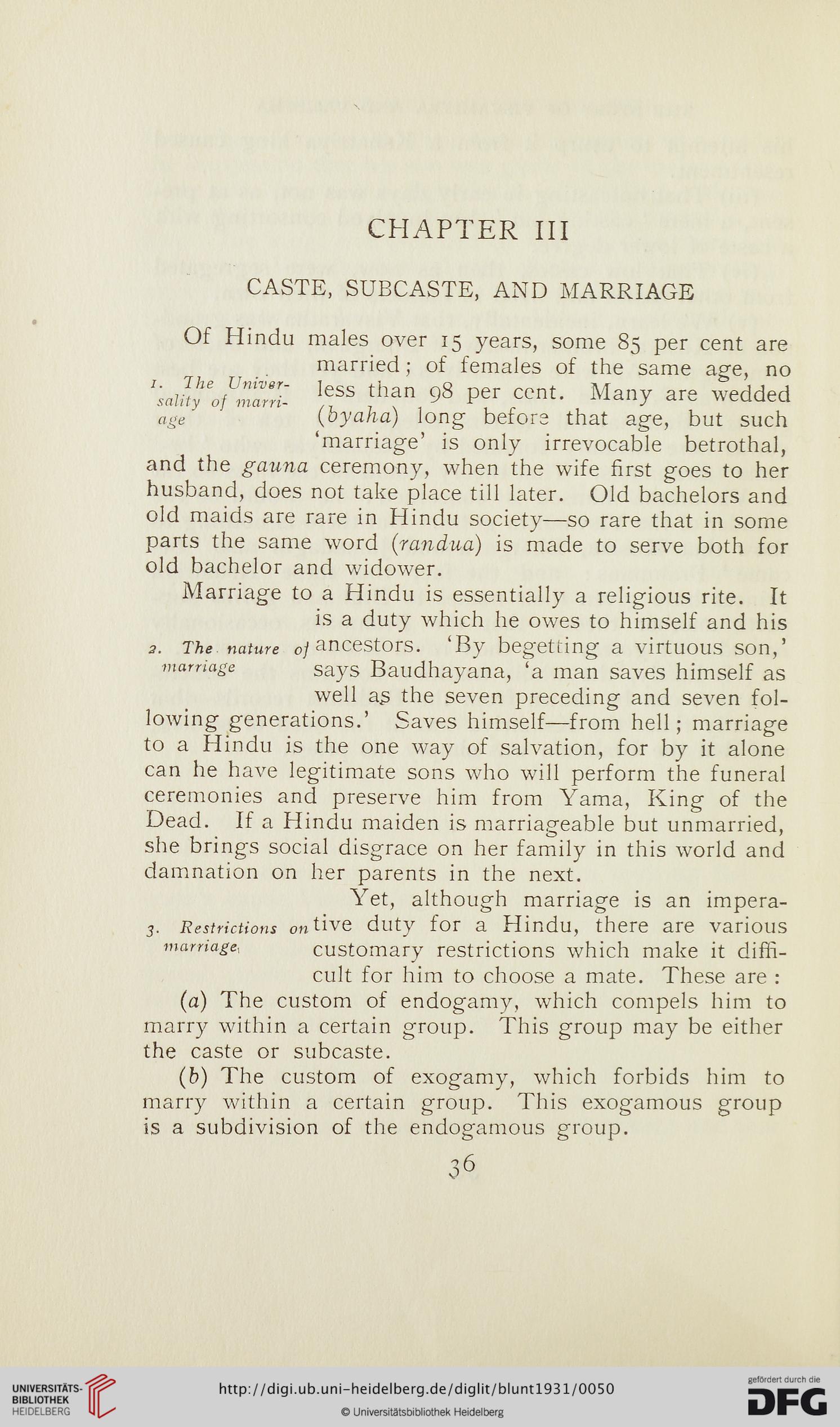CHAPTER III
CASTE, SUBCASTE, AND MARRIAGE
Of Hindu males over 15 years, some 85 per cent are
married; of females of the same age, no
7; Jhe Umver- less than 98 per cent. Many are wedded
'lgey marri (byaha) long before that age, but such
‘marriage’ is only irrevocable betrothal,
and the gauna ceremony, when the wife first goes to her
husband, does not take place till later. Old bachelors and
old maids are rare in Hindu society—so rare that in some
parts the same word (randua) is made to serve both for
old bachelor and widower.
Marriage to a Hindu is essentially a religious rite. It
is a duty which he owes to himself and his
2. The nature o] ancestors. ‘By begetting a virtuous son,’
marriage says Baudhayana, ‘a man saves himself as
well as the seven preceding and seven fol-
lowing generations.’ Saves himself—from hell; marriage
to a Hindu is the one way of salvation, for by it alone
can he have legitimate sons who will perform the funeral
ceremonies and preserve him from Yama, King of the
Dead. If a Hindu maiden is marriageable but unmarried,
she brings social disgrace on her family in this world and
damnation on her parents in the next.
Yet, although marriage is an impera-
3. Restrictions ontive duty for a Hindu, there are various
marriage, customary restrictions which make it difii-
cult for him to choose a mate. These are :
(a) The custom of endogamy, which compels him to
marry within a certain group. This group may be either
the caste or subcaste.
(b) The custom of exogamy, which forbids him to
marry within a certain group. This exogamous group
is a subdivision of the endogamous group.
3 6
CASTE, SUBCASTE, AND MARRIAGE
Of Hindu males over 15 years, some 85 per cent are
married; of females of the same age, no
7; Jhe Umver- less than 98 per cent. Many are wedded
'lgey marri (byaha) long before that age, but such
‘marriage’ is only irrevocable betrothal,
and the gauna ceremony, when the wife first goes to her
husband, does not take place till later. Old bachelors and
old maids are rare in Hindu society—so rare that in some
parts the same word (randua) is made to serve both for
old bachelor and widower.
Marriage to a Hindu is essentially a religious rite. It
is a duty which he owes to himself and his
2. The nature o] ancestors. ‘By begetting a virtuous son,’
marriage says Baudhayana, ‘a man saves himself as
well as the seven preceding and seven fol-
lowing generations.’ Saves himself—from hell; marriage
to a Hindu is the one way of salvation, for by it alone
can he have legitimate sons who will perform the funeral
ceremonies and preserve him from Yama, King of the
Dead. If a Hindu maiden is marriageable but unmarried,
she brings social disgrace on her family in this world and
damnation on her parents in the next.
Yet, although marriage is an impera-
3. Restrictions ontive duty for a Hindu, there are various
marriage, customary restrictions which make it difii-
cult for him to choose a mate. These are :
(a) The custom of endogamy, which compels him to
marry within a certain group. This group may be either
the caste or subcaste.
(b) The custom of exogamy, which forbids him to
marry within a certain group. This exogamous group
is a subdivision of the endogamous group.
3 6





